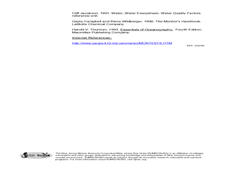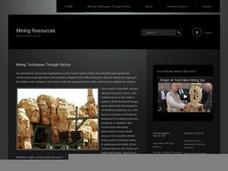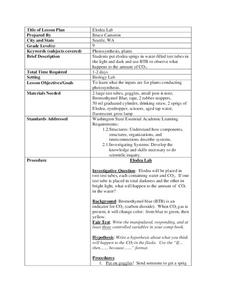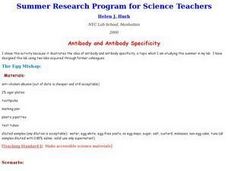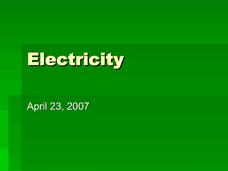Curated OER
Water Quality Monitoring
Students comprehend the four parameters of water quality. They perform tests for salinity, dissolved oxygen, pH and clarity or turbidity. Students comprehend why scientists and environmental managers monitor water uality and aquatic...
Curated OER
Froth Flotation
Sixth graders experiment with the froth flotation process to extract metallic ore by using basic chemicals and equipment in the science classroom.
Curated OER
Elodea Lab
Students observe the changes between elodea leaves placed in darkness and light. In this life science lesson, students experiment to find evidence of photosynthesis in elodea leaves. Students use indicators to detect the presences...
Curated OER
Ball Bearing Roller Coasters and Teamwork Lab
Students discuss potential and kinetic energy and design roller coasters to study this concept. In this energy lesson, students discuss the potential and kinetic energy of a roller coaster. Students design roller coasters and hypothesize...
Curated OER
Antibody and Antibody Specificity The Egg Mishap
Young scholars investigate a set of foods to find the presence of eggs after designing an experiment that will complete the test. They complete a test and discuss antibody-antigen specificity.
Curated OER
Solubility and Chemical Changes in Groundwater
Students test pH of water before and after it travels through different substrates (igneous pebbles and limestone) to detemine how soluble materials can affect groundwater. They answer questions such as: What happended to the pH of the...
Curated OER
Extraction of DNA from White Onion
Students conduct lab test with minced onion to determine where chromosonal DNA is located within the cell, and whether or not it can be extracted.
DiscoverE
Nanosolutions
There are a billion reasons to use the resource! Well, not quite. A demonstration using food color and water shows scholars the meaning of nano. An iterative process results in diluting the concentration of food coloring by one tenth...
Curated OER
Hydrogen
Unique properties of hydrogen, its production, and reaction with other elements make this slide show uncommon. The appearance, however, is common with plain white background and only black and red font, a formatting issue on the second...
Curated OER
Electricity
The presentation begins with a circuit building activity and two data tables for young scientists to copy and complete. Full of clever animations, it will definitely spark student interest! However, the information is incoherent. You may...
Curated OER
Measurement of the Depth of the Ocean
Students comprehend the physical properties of pressure and Boyle's Law by designing a depth gauge. They construct a capillary depth gauge and calculate the calibrated depth marks of the capillary tube. They determine the margin of error...
Curated OER
Why Does the Bulb Light When There is Flow?
High schoolers analyze light bulbs and their design. They create filaments and build a circuit for testing the filaments. Through experimentation, students discover how filament wire works. They explore the role of protons, electrons,...
Curated OER
Paperplane Flying Circus
Young scholars create paper airplanes. They compare and contrast the airplanes created in class and test them out. They adjust their airplanes until they all fly. They discuss the forces that allow flight to occur.
Curated OER
pH Readings and Salinity Readings of Water From Three Locations Within the Neponset River Watershed
Sixth graders test the ph levels of water from three different water environments within the Neponset River Watershed. They discuss the three different water environments, take pH measurements of the three samples, and predict which...
Curated OER
Spectrophotometry Lab
Students use a machine called a spectrophotometer to determine how much light is absorbed by certain substances. Students record the absorbance and the % of light transmitted for different color solutions, graph their results, and then...
Curated OER
Ester Lab
Students investigate making esters in the lab. In this ester lesson plan, students mix 3 organic acids with 3 alcohols and a catalyst to form 3 different esters. Students identify the odors of each ester and write the formulas for the...
Curated OER
Ester Lab
In this ester worksheet, students mix organic acids with alcohols to produced esters and identify the products by the chemical reaction and the scent given off after the reaction occurs.
Curated OER
Chemical and Physical Changes Lab
In this chemical and physical change learning exercise, students conduct a variety of experiments with unknown solutions and make observations. Students determine if the properties of the solutions have changed and if there is...
Curated OER
Periodic Properties Lab
Young scholars investigate the periodic properties of elements in the periodic table. In this periodic properties lesson plan, students experiment with elements from the Alkaline Earth Metals, the Halogens, the Transition Metals, and for...
Curated OER
Types of Chemical Reactions Lab
In this chemical reactions activity, students experiment with several different reactions and identify each as a single replacement, double replacement, synthesis, decomposition or combustion reaction. Students observe the changes in...
Creative Chemistry
Some Halogen Chemistry
In this halogen chemistry learning exercise, high schoolers complete a practical to gain experience observing inorganic halogens and their salts. They observe changes in each chemical reaction and write the chemical equation for each...
Curated OER
Reactions of Metals with Water, Acid and Air
In this chemical reactions learning exercise, students experiment with reactions between 4 different metals with water, acid and air. Students make observations of copper, iron, zinc and magnesium with water, acid and air. They write an...
Creative Chemistry
The Effect of Concentration Changes on Equilibrium
In this concentration changes and equilibrium activity, learners experiment with iron (III) ions and thiocyanate ions to observe the effects of concentration on the equilibrium of solutions. Students observe their mixtures, explain the...
Alabama Learning Exchange
Observation of Yeast Growth
Middle schoolers build an apparatus to look at how yeast cells grow by converting food to energy. They observe yeast both with and without food and see how yeast produces carbon dioxide.
